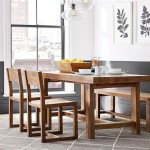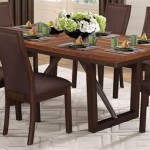Optimal Light Fixture Height Above Dining Room Table
The placement of a light fixture above a dining room table significantly impacts both the aesthetic appeal and functionality of the space. Achieving the correct height ensures adequate illumination for dining, conversation, and other activities, while also contributing to the overall ambiance of the room. Determining this optimal height requires consideration of several factors, including the size and shape of the table, the style of the fixture, the ceiling height, and the desired aesthetic effect.
A light fixture that is hung too low can obstruct views, create a sense of claustrophobia, and potentially cause glare, which can be uncomfortable for those seated at the table. Conversely, a fixture hung too high may fail to provide sufficient task lighting, leaving the table surface dimly lit and creating a less inviting atmosphere. Therefore, careful planning and precise execution are essential to achieving the ideal balance between form and function.
Standard Recommendations for Light Fixture Height
While individual preferences and specific room characteristics will ultimately dictate the ideal height, a general guideline serves as a reliable starting point. The standard recommendation is to hang the bottom of the light fixture approximately 28 to 36 inches above the dining room table. This measurement typically applies to standard 8-foot ceilings. For ceilings higher than 8 feet, the fixture should be raised proportionally, adding approximately 3 inches for each additional foot of ceiling height.
For example, in a room with a 9-foot ceiling, the ideal height above the table would be closer to 31 to 39 inches. This adjustment ensures that the fixture remains visually balanced and provides adequate lighting coverage. These measurements serve as a baseline and should be adjusted based on the specific characteristics of the light fixture being used. For instance, larger or more ornate fixtures may require a slightly higher placement to avoid overwhelming the table setting, while smaller or more minimalist fixtures may benefit from a slightly lower placement to provide more focused light.
The type of light fixture significantly influences the perceived brightness and distribution of light. Chandeliers, with their multiple light sources, generally require a higher placement than pendant lights, which typically feature a single light source. Similarly, fixtures with exposed bulbs may need to be hung higher to minimize glare, while fixtures with shades or diffusers can be positioned slightly lower without causing discomfort. Therefore, a thorough understanding of the light fixture's design and light output is crucial for determining the optimal hanging height.
Factors Influencing Light Fixture Height
Beyond the standard recommendations, several additional factors should be considered when determining the ideal height for a light fixture above a dining room table. These factors include the size and shape of the table, the style of the light fixture, the existing décor of the room, and the personal preferences of the homeowner. These elements work in conjunction to create a cohesive and visually appealing space.
The size and shape of the dining room table play a significant role in determining the appropriate height of the light fixture. A larger table typically requires a larger or more visually substantial fixture, which may necessitate a higher placement to avoid obstructing views and creating a sense of imbalance. Conversely, a smaller table may benefit from a smaller or more minimalist fixture, which can be positioned slightly lower to provide more focused light.
The shape of the table is also a key consideration. For round tables, the light fixture should be centered directly above the table, with the bottom of the fixture positioned at the recommended height. For rectangular or oval tables, the fixture should be centered lengthwise along the table, again with the bottom of the fixture positioned at the recommended height. In some cases, multiple smaller pendants may be used above a long rectangular table, spaced evenly along the length of the table to provide consistent illumination.
The style of the light fixture should complement the overall décor of the dining room. A modern or minimalist fixture may benefit from a slightly lower placement to emphasize its clean lines and understated design, while a more traditional or ornate fixture may require a higher placement to showcase its intricate details and grandeur. The color and finish of the fixture should also be taken into consideration, as these factors can influence the perceived brightness and distribution of light.
The existing décor of the room, including the furniture, wall colors, and artwork, should also be considered when determining the ideal height for a light fixture. The fixture should be positioned in a way that complements the other elements of the room, creating a cohesive and visually balanced space. For example, if the dining room features tall furniture or artwork, the light fixture may need to be hung slightly higher to avoid competing with these elements and creating a cluttered appearance.
Practical Considerations and Installation Tips
Beyond the aesthetic and functional considerations, practical considerations such as accessibility and ease of maintenance should also be taken into account when determining the ideal height for a light fixture. The fixture should be positioned in a way that allows for easy access for cleaning and bulb replacement, without requiring excessive reaching or the use of specialized tools.
Before installing the light fixture, it is essential to carefully measure the height of the ceiling and the table, and to calculate the desired height of the fixture based on the recommendations outlined above. It is also important to consider the weight of the fixture and to ensure that the ceiling junction box is capable of supporting the weight safely. If the junction box is not adequately supported, it may be necessary to install additional bracing to prevent the fixture from falling.
When installing the light fixture, it is recommended to use a level to ensure that the fixture is hanging straight and plumb. This will help to prevent the fixture from appearing crooked or uneven, which can detract from the overall aesthetic appeal of the room. It is also important to carefully tighten all screws and connections to ensure that the fixture is securely mounted and will not wobble or sway. For heavier fixtures, it may be beneficial to enlist the help of a second person to assist with the installation process.
After the light fixture has been installed, it is recommended to test the lighting at different times of day to ensure that it provides adequate illumination under various conditions. If the lighting is too bright, it may be necessary to use a dimmer switch to adjust the light level to a more comfortable setting. If the lighting is not bright enough, it may be necessary to use a higher wattage bulb or to add additional light sources to the room.
Choosing the right light bulb is also crucial for optimizing the functionality and aesthetic appeal of the dining room. Different types of light bulbs produce different colors and intensities of light, which can significantly impact the ambiance of the room. For example, incandescent bulbs typically produce a warm, yellowish light that is ideal for creating a cozy and inviting atmosphere, while LED bulbs offer a wider range of color temperatures and are more energy-efficient. The choice of light bulb should be based on the desired aesthetic effect and the specific needs of the dining room.
Furthermore, consider the downward projection of the light. Does the shade direct the light down onto the table? Or does it emit light in all directions? For dining rooms, downward focused light is generally preferred as it illuminates the food and the center of the table, creating a more intimate and focused dining experience. If the shade is translucent or allows light to escape upwards, be sure the bulb is not too bright to cause distracting glare.
Ultimately, selecting the optimal height for a dining room light fixture is a complex process that requires careful consideration of numerous factors. By following the guidelines and tips outlined above, homeowners can achieve the perfect balance between form and function, creating a dining space that is both visually appealing and functionally effective.

Lighting Tips How To Light A Dining Area

How To Size A Dining Room Chandelier 3 Easy Steps

10 Design Tips That This Girl Lives By

How To Hang A Chandelier At The Perfect Height Over Dining Table Mod Lighting

The Correct Height For Dining Room Lighting Lightbox

The Ultimate Guide To Pendant Lighting For A Cozy Home Delmarfans Com

The Correct Height For Dining Room Lighting Lightbox

How To Hang A Chandelier At The Perfect Height Over Dining Table Mod Lighting

How High To Hang A Dining Table Chandelier For 10 Foot Ceiling

How To Hang A Dining Room Chandelier At The Perfect Height








